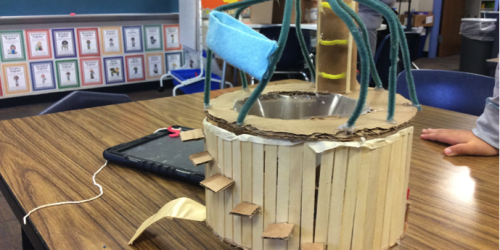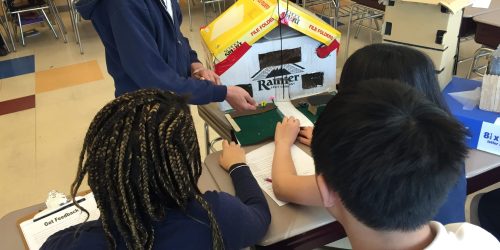
By Elissa Milto, Director of Outreach
This past April, Tufts CEEO’s first book was published — Novel Engineering, K-8: An Integrated Approach to Engineering and Literacy — by NSTA Press! The book, a collaboration between CEEO members past and present, was an exciting way for the authors to reconnect and synthesize research and lessons learned during the research portion of the project that was funded by the National Science Foundation. Tufts CEEO gets numerous requests for Novel Engineering professional development (PD) from schools around the world, but is not able to work with everyone who requests PD. In an effort to help interested teachers, authors Elissa Milto, Merredith Portsmore, Jessica Watkins, Mary McCormick, and Morgan Hynes, who all worked on the research behind Novel Engineering, created this book so teachers who cannot work directly with the CEEO are able to understand how to do Novel Engineering with their students.
The CEEO loves Novel Engineering because it gives students the chance to follow their own ideas. In Novel Engineering, students identify problems in books they read and then design and build solutions for the characters. The students become invested in what they are building and build empathy for the characters, using what they’ve read about as evidence for their design decisions. We’ve found that integrated engineering and literacy are mutually beneficial for students’ learning. Although this sounds like a simple concept, implementing the Novel Engineering approach in the classroom is complex. The Novel Engineering book was written to guide teachers through implementation.
The Novel Engineering book will also be used to support Novel Engineering PD and the online Integrating Engineering and Literacy graduate-level course offered by the CEEO. The book’s three sections (What is Novel Engineering? Case Studies from the Classroom, and Enacting Novel Engineering) walk educators through the background and pedagogical information they need in order to implement Novel Engineering with their own students. We’ve included lots of student work so that educators can see what Novel Engineering looks like in a classroom and so they can begin to anticipate what their own students might do. We look forward to talking to teachers who use the book and hearing about the solutions their students design.
On June 9th at 3:00, an informational webinar will be held to answer questions related to Novel Engineering. It will be a chance for educators who are new to Novel Engineering to hear more about our programs and for those who have tried it to ask questions. In the meantime, an overview of Novel Engineering can be found at www.novelengineering.org.
Bidirectional Benefits
Peter’s Chaise – from Peter’s Chair by Ezra Jack Keats
Place for Peter since his parents gave his chair to his newborn sister
Carrier so Nya can carry water more comfortably over her long walks to get water
Long Walk to Water by Linda Sue Pa


